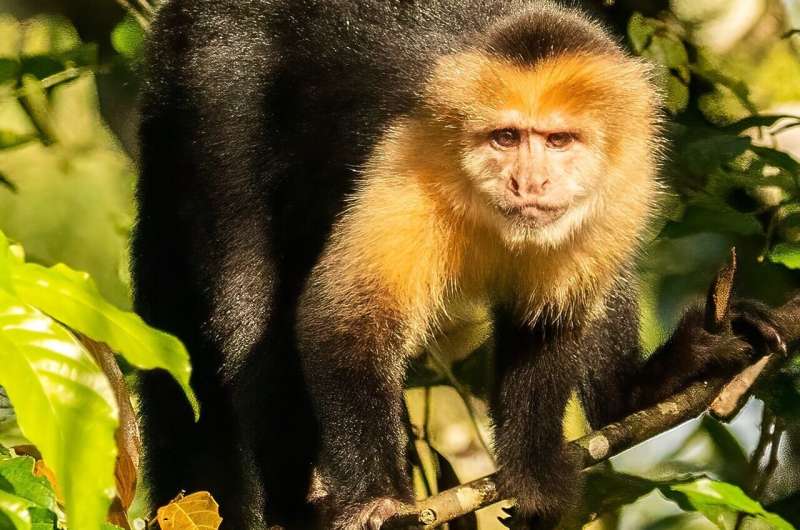This article has been reviewed according to Science X's editorial process and policies. Editors have highlighted the following attributes while ensuring the content's credibility:
fact-checked
trusted source
proofread
Primatologist observes how monkeys change behavior to survive deforestation

Deep within the forest, monkeys can be very social creatures: they play, fight, vocalize, and even groom one another within their social groups. But as University of Toronto Mississauga primatologist Laura Bolt and her colleagues have recently discovered, these primates are quick to alter their natural social behaviors—and adopt new ones to ensure their survival—when their environments are impacted through deforestation.
"One trend we're seeing with primates worldwide is that when their forests are cut down, they're either able to adapt in some way, or their population declines," explains Bolt, an adjunct professor of anthropology UTM. She is also a member of the board of directors of Maderas Rainforest Conservancy in Costa Rica and the director of a research project at the La Suerte Biological Research Station (LSBRS) called "The La Suerte Forest Fragmentation and Primate Behavioral Ecology project."
Primatology in Costa Rica is at a pivotal juncture, Bolt says. "We wanted to survey them before they're on the edge of extinction, as a way of maybe informing conservation plans to preserve some of their landscapes."
Bolt, along with research collaborator professor Amy Schreier at Regis University, detail their findings in their paper "Edge effects and social behavior in three platyrrhines," which was published in the American Journal of Primatology.
This study is also co-authored by former students from around the world who gained experience at the LSBRS field school and returned to continue their research. The primate field school is open to UTM undergraduate students as a course credit.
Between 2017 and 2023, Bolt and her colleagues studied the social behavior of monkeys at the LSBRS primate field school, which is located in northeastern Costa Rica and operated by the Maderas Rainforest Conservancy. The site is an anthropogenically altered tropical rainforest, meaning part of it has been changed by humans. It includes human-altered forest edge areas that are close to clear-cut areas such as cattle pasture or agricultural fields. The site also has undisturbed forest interior areas located further away from clear-cut areas.
Bolt and her colleagues specifically studied the social behavior of Central American spider monkeys, white-faced capuchin monkeys, and mantled howler monkeys. They observed these primates' social behavior when they lived in the undisturbed forest area, and compared it to how they behaved in clear cut areas along the forest's edge.
While observing spider monkeys, the team discovered that these primates engaged less in social behaviors overall when living along the forest edge—likely because they had to conserve their energy.
"Spider monkeys are adapted to be in the highest parts of the canopy all the time when they move. They also prefer to eat specifically lipid-rich fruit like figs, which tend to come from very tall and mature trees," says Bolt.
"In forest edges, trees tend to be a lot smaller. That means spider monkeys can't find what they need in terms of food, and they don't have sufficiently tall trees to be able to travel quite as easily. So, they try to use less energy in general when they're in forest edges."
The research team also found that white-faced capuchin monkeys, which are quite small and vulnerable to predators, engaged in behavior that wouldn't draw attention to themselves. For example, these primates vocalized and fought less often while living along the forest edge.
"If they're in an area with smaller trees, where it's easier for predators to see them, they're especially vulnerable," Bolt says. "It makes sense that the capuchins would try to avoid getting eaten, essentially."
Howler monkeys, however, didn't appear to change their social behavior along the forest edge—which Bolt says was a somewhat surprising finding.
In previous research, she and her colleagues have found that howler monkeys change how much they eat and travel while living in different forest areas. But, past research has also shown that howler monkeys aren't as adaptable overall when living in different environments.
"This could be a concern long-term for howler monkeys. They might be only capable of living one way and then they persist until suddenly, they die out because they're not able to cope," Bolt explains.
She says that studying primates' social behavior builds on her previous work related to how habitat destruction impacts species on the verge of distinction, for example, ring-tailed lemurs in Madagascar.
"Studying social behavior is such a good way of understanding their quality of life, and whether they're happy," she says. "Understanding how species behave is a way of better understanding them, and better understanding how to conserve them."
More information: Laura M. Bolt et al, Edge effects and social behavior in three platyrrhines, American Journal of Primatology (2024). DOI: 10.1002/ajp.23610
Provided by University of Toronto Mississauga




















